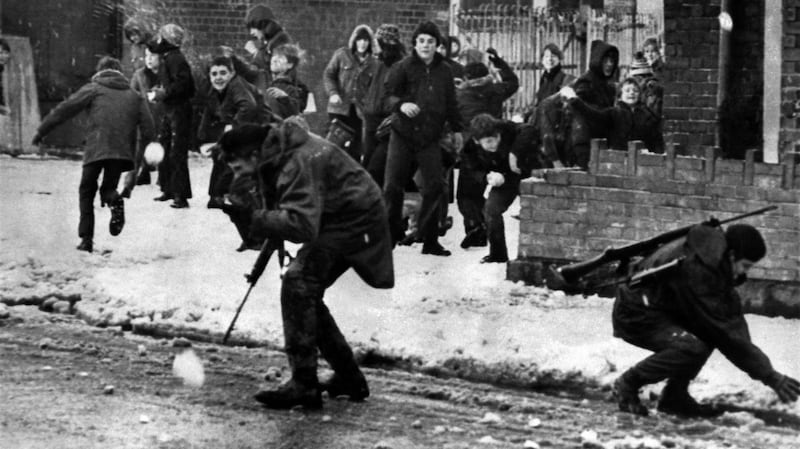
It was the first of the summers of blood. The handsomest boys in Ardoyne have murder in their hearts, Perry Como on their lips and good times on their mind. David Keenan said his first novel, This Is Memorial Device, was a personal hallucination – in For the Good Times Northern Ireland in the 1970s is a collective hallucination, a messianic in-joke laced with high-octane, foul-mouthed and ultra-violent high jinks. The boys are IRA or something like it – nothing's simple in this world except the sex and violence. Sometimes you're in a six-county slasher epic, in other times transcendence interposes. The story goes like this: the boys emerge from Ardoyne, all guns blazing. Pulp murder is the modus operandi: their targets are shot in the face, butchered in front of their mothers; kidnap and intimidation part of the routine.
The aesthetic is that of the New England Library of the 1970s, the Skinhead and Hell’s Angels books. The boys take over a comic book shop. The narrator, Sammy (or sometimes Xamuel – Belfast boy as Blakeian fallen angel) falls for the owner’s wife. There’s leotard and legging sex on nylon sheets in the Europa Hotel. There are conversations with the dead. There are the H-Blocks and Bobby Sands.
Tommy is the charismatic one. He’s the charmer, the lounge crooner standing in the gates of hell, the one the girls adore. He’s the one strapped to the roof of the getaway car, guns blazing as the boys exit Dundalk after a hit.
Everything is transfigured. The author of the Sniper at Work signs emerges as a scorched and disfigured situationist, the burnt man who locked himself into the British embassy and into his art in Dublin when it was torched by a Free State mob in 1972. There is a parallel narrative where Neutrino and the Anomaly enter the Dead Zone, the comic book world dropping through a black hole into the present of spilled blood and sorrows. Nordie argots fleshed-out into testamentary chant. Bad Paddy jokes repeated until they become incantation. Renegade nights in Belfast rendered as high-end manga.
Cosmic artfulness
The driven, furious narrative holds it together, everything teetering at the edge of comprehension. You can't tear your eyes away. Which is what it was like. The real thing felt more like For the Good Times than it did like anything else. Under the cosmic artfulness there is a hardcore authenticity to this telling.
There is a mining of the unexpected coming out of the North. You’d be afraid to call it a movement, you’d be brave to call it a reimagining. The honed narratives are coming apart under their own necrotic weight, the well-made making way for the fractals of broken consciousness. Anna Burns. Michael Hughes. What it says is this: it can be told as many ways as you like, the 30 years of war can bear as many meanings as you can layer on to it and still feel beyond human precedent. The North as dystopian dead zone. The North as Ouroboros. The players have ceded the ground to art, and who can tell whether that is a good or a bad thing?
Nothing here is going to end well. The boys are going to pay for the glory days. Tommy is a bad end waiting to happen and the hunger strikes are just around the corner. Betrayal is always on the cards and the boys have been undermined from the start. Honey traps have been set, and the viruses spread. Brit intelligence steps into the frame. The Belfast ’Ra, it seems, are “Pathogens of our own making ... psychopathogens. That’s another word for a fenian bastard and we’re flooding the market.”

Awareness of the flesh watermarks: flesh tortured and elevated, brutal and loveless sex, the mortification of the self-starved, Christ displaying his wounds. The burnt man meditates on the flesh as a prison and a penance.
Faithful to the core
There's a cultural map of the era running through For the Good Times: Donna Summer and the Furry Freak Brothers, Old Spice and the Tibetan Book of the Dead, but these are the textures of the time and they are there as detail and waypost, faithful to the core. Keenan has a way of pulling the rug out from under you – one minute you're in a freeze-frame from some under-the-counter glossy mag of the period, darkness falling on the streets outside, the next you're falling through a spiral nebula of brilliantly conceived anime pastiche.
American poet Amy Clampitt wrote “street gangs amok among magnolia’s tender wands”, and it is imagistic juxtaposition that feeds the deep-felt compassion and profundity of this book. Here’s Sammy in the H-Blocks during the hunger strikes: “If you could enter the eyes of a dead man, the black inscrutable eyes of a dead man, at mass, in H3, in the years of the hunger strikes, then you would come to know that heaven and hell are just party games played for the benefit of the living.”
This is visionary fiction, occult in intent, brilliant in execution. The North’s bequest of the unsaid and the never-to-be-said are beginning to be addressed, with Keenan among salutary others finding the words.















